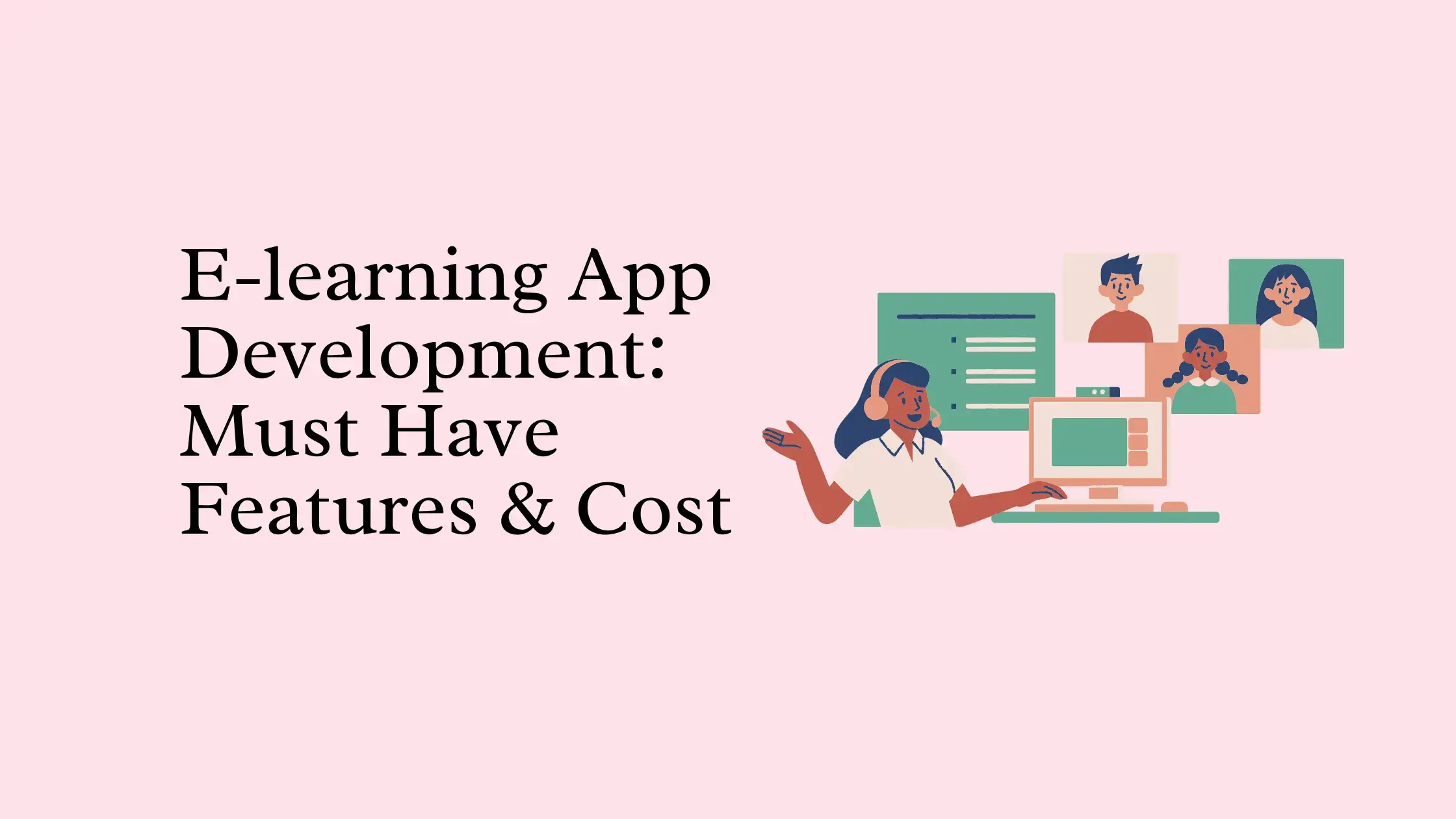Every company has been on a digital transformation journey and is introducing innovations on the horizon of technology each day. Desktop applications have brought new literacy levels to new levels of e-learning apps which are now a fundamental part of smartphones. It is possible to start learning anytime, anywhere, using smartphone e-learning apps. The good thing is that most functions are diverse and can even function offline. Therefore, you don’t always need to access these courses via the internet via a dedicated connection.

The world is witnessing revolutionary changes in the educational sector, including smart classrooms, online learning programs, and other apps that provide a platform where children can learn regardless of their capabilities.
The growth of mobile Apps for Education and Learning
Today, we reside in a world where nearly every aspect of our life, whether fitness, entertainment, or social networking, is controlled. Every day there is a 10x increase in the need for smartphone apps. In the e-learning market, the demand for online learning apps is also growing exponentially.
The rationale behind the rapid growth of mobile applications is that they offer learners or students easy learning and comfort. Modern technology – starting from the simplest stage and up through the higher levels- can be understood by students and online learning apps with access 24/7. Additionally, online learning applications permit students to upload their homework quickly and tutorials, access online tutor assistance, and more. Technology advancements in e-learning are improving the smartphone applications of students across the world. Technologies like Artificial Intelligence, Machine Learning, and AR/VR aid students in learning by using mobile apps.
The benefits of e-learning app development
Mobile apps for learning enable users to learn information through podcasts or videos and other means. Mobile apps for education encourage students to study at their pace and can repeat themselves if they do not comprehend the concept. The applications for learning online have a greater level of student engagement than traditional training methods, resulting in more rapid completion and retention. Students can interact with and watch learning more actively. Mobile learning applications enable parents to observe the performance of their employees. The company’s management can also monitor its employees’ efficiency.
The online learning approach is suitable for everyone, and the field of software development has grown exponentially. This revolutionary change has led to incredible improvements in the use and cost of communication and sharing content. Different executives working within households and workplaces can opt to take online courses in e-learning whenever required. You can browse through the material repeatedly and not have to attend classes in a classroom that is e-learning-based. This is particularly true during correction when you are studying for an exam. Following the standard learning method, you should learn the entire topic independently if you can’t take the class. However, e-learning allows you to take advantage of the subjects you want to explore.
The primary advantage of e-learning is that it ensures that the platform for learning e-learning is compatible with other learners. This allows the student to access and refresh their content or program. In addition, it is a quick-track method of learning. It is comparatively rapid in comparison to the traditional classroom method.
How can you build an E-learning App to help your business?
The types of apps for e-learning
Before beginning to build, you must determine what kind of site you wish to create. For example, educational platforms can be classified into learning strategies and audiences. However, these categories can also be subdivided into subtypes.
Applications based on Mode of Learning:
This kind of education allows students to select their preferred learning method. For instance, games and video tutorials are interactive tools. Certain programs also provide group classes if students want to work with colleagues or make new acquaintances.
Computer Managed Learning (CML) and CAI (Computer-Assisted Instruction):
CML is a term used to describe computers that manage learning and access. These systems have databases that contain the material that students require to learn. Concerning CAI, it employs software, such as graphics, video, and text, to enhance the learning process and traditional teaching methods.
Asynchronous and Synchronous Online Learning:
Synchronous online education allows learners across the globe to learn together. Utilizing platforms like Zoom or Google Hangouts includes video and online chats. Asynchronous learning is a form of individual education where learners are grouped to discuss their learning outcomes and successes.
Adaptive e-learning:
Fixed schooling is the term used to describe the system that does not offer students individual paths as all study materials are developed ahead of time. Instead, adaptive e-learning adapts and re-designs content based on users’ preferences, as evident from the name.
Digital Educational Study:
Online interactive training facilitates students’ communication with instructors, simplifying adapting learning plans and methods.
Applications made by Target Audience
Educational websites could also be classified based on the demographics of the customers using their services.
● Students at universities and colleges
● Teachers and children
● Students and professors of the language
● Specialized experts in a certain area
● Development Process
- Make a list of ideas
It is a fundamental step without which development can’t begin. First, ensuring your concept is unique and well-loved by the market is important. Next, conduct a thorough study of the competitors in the field you want to enter, then look over the customer feedback to determine if they are satisfied with the service the competitors provide and choose what you can improve on to improve your service.
2. Recognize your target audience
The proof of concept can allow you to consider the gaps that can be filled by competing applications to improve the user experience. This development of mobile apps for e-learning will help you determine what your app’s e-learning content will be aimed at. It’s time to talk to your customers about your solution and decide what they expect. Attend conferences and address the crowd or listen to the audience’s opinions. This will give you a feature list to incorporate an accurate perspective. It is recommended to visit discussion forums to get to know the people there and learn about their views and opinions. This is the list of features you must incorporate for a clearer perspective.
3. Begin with UX/UI design workThe appearance and design of your software for e-learning are also important aspects. It is essential to ensure a great design and offer a superior service to your computer’s users. The variety of colors and features, functions, and navigation facilitates the growth of every aspect of your app for learning. It is easy to create your requirements with the design team at UX/UI. Be clear about your needs.
4. Think about MVPMinimum Viable Product, also known as MVP, is a variation of a product with distinct functions. It only can satisfy the initial users. Due to the focus on the most important aspects, the most significant benefit is the shorter time to market. Lower production costs go along with quicker market time. MVP provides a huge opportunity for growth. After the release, you may continue to add additional features. Additionally, MVP allows you to examine and modify your product’s market for the best fit.
5. Make a monetization model work.We’re trying everything to achieve these gains in the business. Make sure you choose a model for monetization which will enable you to get the most returns. In the next segment, we’ll explore various methods of monetization. Here are a few fundamental things you need to keep in mind before the team takes charge of the task. You could put the information you’d like to put on the computer, but don’t forget to communicate your ideas!
A few must-haves for an application that teaches online
The development of E-learning applications begins with the definition of the feature list. Although numerous E-learning apps employ various techniques and features, each application has a few fundamental elements.
1. Student Module
2. Registration
3. Login
4. Course Catalog
5. Search Bar
6. User Profile
7. Course Details
8. Payments
9. Subscriptions
10. Teacher Module
11. Registration
12. Students Management
13. Test Management
14. Course Management
15. Content Update
16. Payments
17. Doubt Clarification sessions
18. Chat Management
19. Parent Module
20. Registration
21. Progress Monitoring
22. Attendance Monitoring
23. Reviews
24. Payments
How can e-learning apps be commercialized?
Purchases in-app
A developer can include the purchase of course materials and other courses. Users can purchase their favorite systems and pay only for the courses they wish to take. A feature that lets users access about 20 percent of the material and later request the content purchase could be added to attract users to use the application.
Membership and Subscription
Under this arrangement, customers can access a basic application that is free and offered for sale at no cost. This approach lets you understand the app’s capabilities and decide if it is the best and what subscription model you want. Additionally, you could enjoy a fully-equipped online learning app for no cost for a set period. A different option would be to motivate users to take advantage of certain software features and encourage users to purchase paid features.
The idea is to make the user more comfortable with online learning. The paid version is pushed slowly until the user is attracted to the free version. It will offer benefits like removing your doubts about teachers, choosing your preferred teacher according to the subject, a greater range of learning history options, early entry into new courses, and other benefits.
Media exposure
In-app advertisements are a typical method to make money from your e-learning application. This monetization method means that the application is free to users, contributing to the app’s rapid growth among users. The media coverage can be pertinent enough not to appear to be a bit stoic.
● Talk about your idea?
● Are you looking for a Scalable Mobile app for your company
● Cost of developing an E-learning platform
The elements that play a major influence on the development cost of an E-learning program:
Applications with a variety of features and difficulties are included.
If the program’s most basic features are utilized, then costs are generally less. In addition, if the program includes advanced features and audio-video integration, it could cost quite a bit.
Platforms to develop the program
The cost will be lower when the app is developed for only one platform: iOS, Android, or a website. In contrast, it will be higher when the app is designed for multiple platforms.
The size and position of development teams
The cost per hour for the development application will differ in each location. Prices also depend on the expertise of the developer you select and the experience of the firm you choose. The development costs will increase as advanced features are included.
Are there any benefits to investing in the development of mobile learning apps?
It is well-known that apps for e-learning can benefit the field of education and that it helps bring more savings in time and money for online learning, brand awareness, etc. When we look at the data and reports, we know that the global education apps market growth could reach almost 243 billion USD shortly. Due to the covid-19 scenario, the possibilities for this market growth are twice. There is plenty of improvement in this industry. In this case, we can assure entrepreneurs that online education app development will be successful for those who choose to begin with it. You’ll have a great opportunity in business, and you’ll be able to expand your business. Be familiar with the following terms before deciding on E-Learning Apps Development Services, E-Learning Apps Development Company, Application Development Services, Interactive Features, Art Education Platform, Business Idea, and Business Model. Online Classroom and Remote Learning.

Dr.Supreena has published two international books in finance with the able guidance of her guide and department at Ethiraj College of Women, University of Madras during her PhD in Economics and Finance. She is the Recipient of Dr Vedagiri Shanmugasundaram (An Oxford Scholar) Award for Outstanding and Successful PhD Candidate from Ethiraj College for Women concerning research record and academic distinction. She is experienced in the domain of finance, digital marketing and information technology writing on Artificial Intelligence, IoT, PaaS and SaaS cloud computing etc. She is NIIT qualified in Advanced Network Computing, Google Certified in digital marketing. Her hobbies to maintain balance and reduce stress are gardening and cooking.


